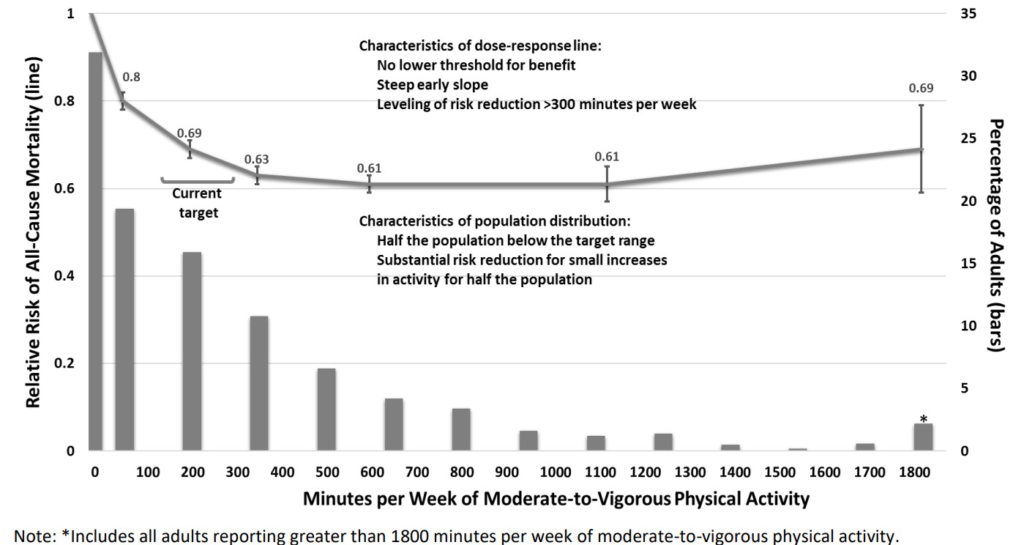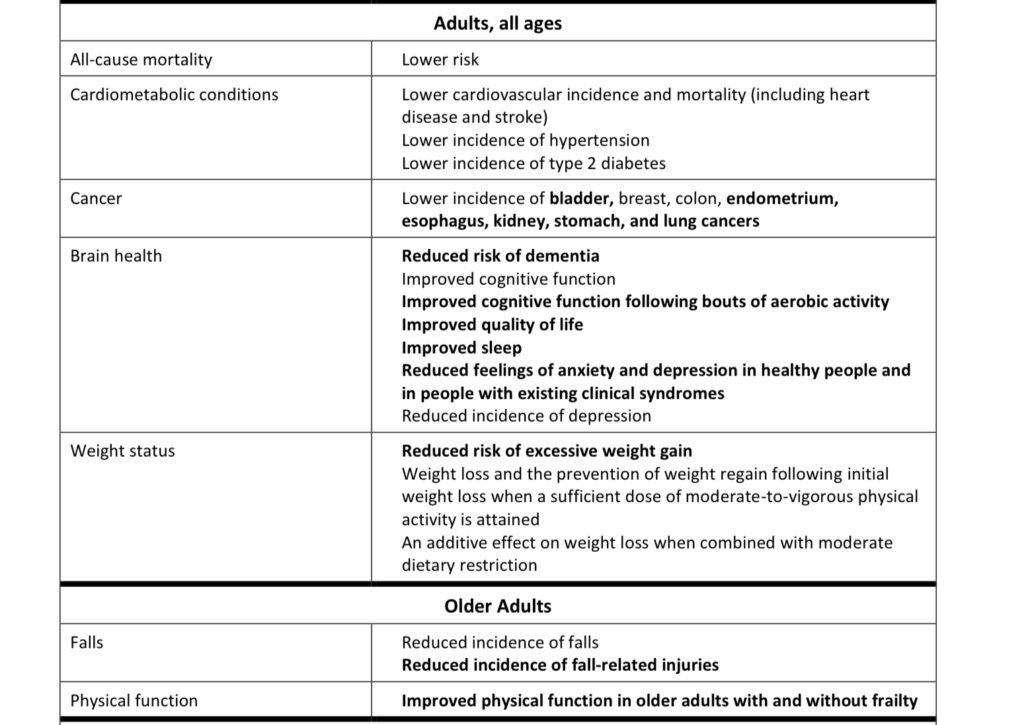You would probably have seen many social media posts within your community that have embarked on fitness regimes. From the bouts of CrossFit, Spartan races, and high intensity interval training, to the recent proliferation of HYROX focusing on running and functional exercises. The hype has spurred many young and middle aged adults to participate in these fitness races. These efforts that are put in, are by no means small feats. It is the combination of social cohesion & fitness community motivation, along with visible physical benefits that continue to attract more fitness enthusiasts to jump on the bandwagon; definitely a laudable effort.
It dawned upon us to ask some pertinent questions when health span is involved. How much exercise would be deemed sufficient for health optimisation? What are the types of physical activities that I should get involved? Is “sky is the limit” where fitness directly correlates to health positively?
Domain of physical activity
To firstly understand and classify physical activity, we need to understand the its measurement through body metabolic equivalent of task (MET). It is a scientific way to measure our body’s expenditure of energy. One MET is defined as the amount of oxygen consumed while sitting at rest, which equates to 3.5ml of oxygen per kg x min (Jetté et al., 1990). For example, sitting and reading a book takes up around 1.3 METs, while running at a pace of 8km an hour takes up approximately between 8-9 METs. Under absolute intensity terms, physical activities are commonly classified into 4 broad categories (The Nutrition Source, 2022):
- Sedentary – 1.5 or fewer METs. (Sitting, lying down)
- Light intensity – 1.6 – 3.0 METs. (Leisure walking)
- Moderate intensity – 3.0 – 6.0 METs. (Walking briskly, performing housework)
- Vigorous intensity – 6.0+ METs. (Running, aerobic classes)
Quantification of exercise volume is often expressed in MET-minutes or MET-hours, typically taking the METs value of a particular activity multiplying by the amount of time spent on the activity. Expanding from the example of running physical activity above classified at 8 METs at the given intensity, 1 hour duration would draw an approximate 480 MET-minutes achieved.

Figure 1: Risk of all-cause mortality against minutes per week of moderate-to-vigorous physical activity (Physical Activity Guidelines Advisory Committee Scientific Report, 2018)
From Figure 1, findings from a 2018 scientific report on physical activity suggest the benefits of adopting approximately 150-300 minutes of moderate-to-vigorous physical activity per week. Exemplified by the curve, it would be the most beneficial for an individual on a sedentary lifestyle to make active moderate exercising a weekly goal. Individuals that exceed the target do get greater benefit, as shown in the Figure on a continued reduction in risk at a macro view. Nevertheless, the main highlight is on the modest increase in physical activity that can have profound difference to all-cause mortality ratio. This golden target of minimum 150-300 minutes of moderate-intensity physical activity would ideally translate to 500-1000 MET-minutes per week. In the case of aerobic activity such as walking, 3 miles (4.8km) per hour which is roughly a brisk walking speed would translate to the target MET-minutes per week. For an individual that engages in high-intensity workout such as aerobic running, the same MET-minutes can be achieved at half the time taken, i.e 75-150 minutes of high-intensity physical activity. This is adopted and advocated by Singapore Physical Activity Guidelines as well, which reinforce the acceptance of the scientific report without any ambiguity.
Apart from all-cause mortality ratio on a wide statistics scale, the findings on the report (2018) further highlighted the benefits of physical activity with moderate to strong evidences on cardiometabolic diseases, cancer incidences, brain health & sleep, as well as the common understanding of weight loss. Interestingly, it further highlights the need for physical activity even in patients with co-morbidities and health conditions, in which it is often perceived and misunderstood that medication & rest (without physical activity) is preferred.


Source: Physical Activity Guidelines Advisory Committee Scientific Report, 2018
Arguably, the same mode of physical activity differs in effort and exertion for different individuals. Hence, METs in an aerobic brisk walking would naturally be a literal walk in a park for an avid runner as opposed to an individual without any exercise habits struggling with BMI issues. As such, we explore exercise dose which can be broken down into intensity, duration, and frequency.
Defining volume through Intensity, Duration & Frequency
The overarching measure of volume through MET-minutes forms the guidance over the sub-components of intensity, duration, and frequency. By defining METs through planned workouts throughout the week, respective physical activities intensity multiplied by its duration can therefore be defined to hit our target MET-minutes objective. It is however interesting to note from the report (2018) that frequency can be varied so long as total MET-minutes target per week is achieved. This means an “exercise debt” can be recovered so long as intended workouts with either increased intensity or duration can be incorporated, albeit on lesser days of the week.
What about cardiorespiratory fitness?
In the measure of HIIT programmes, they are designed to achieve or exceed heart rate (HR) of 85% against max HR value. As such, METs score can be pegged to 11.0 with a one-one, work-recovery ratio; 1 minute workout, 1 minute rest (NOVI Team, 2024). Vigorous physical activity also helps improve cardiorespiratory fitness which helps lower risks of cardiovascular diseases, stroke, and type-2 diabetes (Ross, 2016). In the measure of cardiorespiratory fitness, the growing evidence around VO2max has made its way into a key longevity health span predictor. This is largely due to the efficiency of oxygen transfer and consumption that correlates to heart and lungs function, in which determines our aerobic capacity. Naturally, higher VO2max signals a better cardiorespiratory functionality.

What should we do?
In summary, our recommendations is to actively work towards targeted MET-minutes through vigorous and intense physical activities, in which not only it does contribute to targeted weekly dose of physical activity required, it also helps in cardiorespiratory fitness which draws a positive correlation to your VO2max. Duration taken could be lesser in terms of time taken, yet commensurates with the METs requirement per week which does not compromise on health outcomes. However, the baseline knowledge is to ensure that we are achieving our targeted plan through proper indicators such as:
- VO2max stress test
- Fitness smart trackers (HR monitor)
Vigorous and intense physical activities does not mean that we must only engage with activities that push us towards 85% or more of max HR. 70% max HR is a good indicator of vigorous intensity workout (Kranz, 2024) which can be achieved through many different ways such as swimming, running, circuit training, and sports. It is also important to note that injury risk ratio will definitely increase as exercise intensity increases, depending on the complexity of the movements required and also the equipment associated. As such, there should be an intentional workout ramp starting from moderate intensity; build up personal fitness regime to accommodate bodily acclimatisation and sports complexities to prevent external injuries.
Vigorous to intense physical activities often draw good benefits through muscle conditioning & strengthening, as well as bone health through exercise bone stress. However it is important to note other musculoskeletal functions involvement such as joints mobility, tendons & ligaments which could result in potential injuries and inflammation if not properly executed and warmed up. It is therefore also recommended to seek professional opinion and training coaches to guide us through a meaningful and safe exercise journey, as it should ideally be a lifelong commitment without any injury disruptions and sedentary downtime.
—————
References
Jetté M, Sidney K, Blümchen G. Metabolic equivalents (METS) in exercise testing, exercise prescription, and evaluation of functional capacity. Clin Cardiol. 1990 Aug;13(8):555-65. doi: 10.1002/clc.4960130809. PMID: 2204507.
The Nutrition Source. (2022) Staying Active. Harvard T.H. Chan, School of Public Health.
2018 Physical Activity Guidelines Advisory Committee Scientific Report.
NOVI Team (2024). Are HIIT Workout Benefits All They’re Made Out to Be? NOVI Health. Available at: https://novi-health.com/library/hiit-workout-benefits?format=amp
Ross R, Blair SN, Arena R, Church TS, Després JP, Franklin BA, Haskell WL, Kaminsky LA, Levine BD, Lavie CJ, Myers J, Niebauer J, Sallis R, Sawada SS, Sui X, Wisløff U; American Heart Association Physical Activity Committee of the Council on Lifestyle and Cardiometabolic Health; Council on Clinical Cardiology; Council on Epidemiology and Prevention; Council on Cardiovascular and Stroke Nursing; Council on Functional Genomics and Translational Biology; Stroke Council. Importance of Assessing Cardiorespiratory Fitness in Clinical Practice: A Case for Fitness as a Clinical Vital Sign: A Scientific Statement From the American Heart Association. Circulation. 2016 Dec 13;134(24):e653-e699. doi: 10.1161/CIR.0000000000000461. Epub 2016 Nov 21. PMID: 27881567.
The American College of Sports Medicine (2019). ACSM’s Health-Related Physical Fitness Assessment Manual, 5th edition. Available at: https://www.acsm.org/docs/default-source/publications-files/hrpfam5_table-8-9-updated.pdf?sfvrsn=e82139fc_4
Kranz (2024). Light, Moderate, and Vigorous Activity. South Dakota State University Extension. Available at: https://extension.sdstate.edu/light-moderate-and-vigorous-activity
Leave a Reply